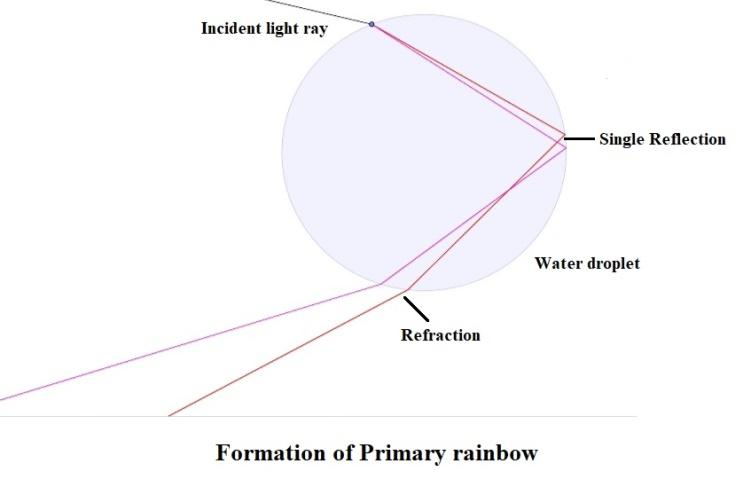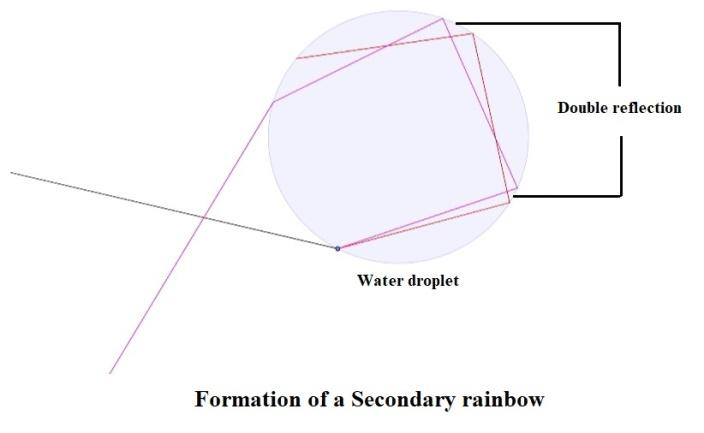
How many times total internal reflection occurs in the drop for formation of primary and secondary rainbows?
Answer
586.2k+ views
Hint: During the formation of the primary rainbow, total internal reflection occurs only a single time while a secondary rainbow is formed by the light ray that underwent total two internal reflections, resulting in the change in order of colours.
Complete step by step answer:
Total internal reflection is defined as the phenomenon of complete reflection of a light ray reaching an interface having less density and the angle of incidence exceeds the critical angle. When the angle of incidence in a medium reaches a certain critical value, the refracted ray lies along the boundary, making angle of refraction equal to ${{90}^{\circ }}$. This angle of incidence is known as the critical angle.
Formation of rainbows results from refraction of Sunlight in falling water droplets and reflection of the light from the back of the droplet. There can be two types of rainbow formed in the sky. One is Primary rainbow and the other one is Secondary rainbow.
The primary rainbow is formed between about ${{40}^{\circ }}$and ${{42}^{\circ }}$ from the antisolar point. The light path involves refraction and a single time reflection inside the water droplet. Primary rainbow is a coloured arc or bow that appears on the water droplets when light from a bright source such as the Sun falls on them. The size of the water droplets determines which colour would be present in the rainbow and the band width of each colour. Rainbow is always seen in the part of sky which is opposite to the light source.

A secondary rainbow appears outside of a primary rainbow and develops when light rays entering the water droplets undergo two internal reflections instead of one as in the primary rainbow. Due to the second reflection, the intensity of light decreases and therefore secondary rainbows are not as bright as primary rainbows. The pattern of colours visible in the secondary rainbow is opposite to the pattern present in the primary rainbow.

Note:
During the formation of a rainbow, refraction always occurs twice, first when the light ray enters the water droplet and secondly when the light ray leaves the water droplet. Reflection occurs single time in case of primary rainbow while reflection occurs twice in case of secondary rainbow.
Complete step by step answer:
Total internal reflection is defined as the phenomenon of complete reflection of a light ray reaching an interface having less density and the angle of incidence exceeds the critical angle. When the angle of incidence in a medium reaches a certain critical value, the refracted ray lies along the boundary, making angle of refraction equal to ${{90}^{\circ }}$. This angle of incidence is known as the critical angle.
Formation of rainbows results from refraction of Sunlight in falling water droplets and reflection of the light from the back of the droplet. There can be two types of rainbow formed in the sky. One is Primary rainbow and the other one is Secondary rainbow.
The primary rainbow is formed between about ${{40}^{\circ }}$and ${{42}^{\circ }}$ from the antisolar point. The light path involves refraction and a single time reflection inside the water droplet. Primary rainbow is a coloured arc or bow that appears on the water droplets when light from a bright source such as the Sun falls on them. The size of the water droplets determines which colour would be present in the rainbow and the band width of each colour. Rainbow is always seen in the part of sky which is opposite to the light source.

A secondary rainbow appears outside of a primary rainbow and develops when light rays entering the water droplets undergo two internal reflections instead of one as in the primary rainbow. Due to the second reflection, the intensity of light decreases and therefore secondary rainbows are not as bright as primary rainbows. The pattern of colours visible in the secondary rainbow is opposite to the pattern present in the primary rainbow.

Note:
During the formation of a rainbow, refraction always occurs twice, first when the light ray enters the water droplet and secondly when the light ray leaves the water droplet. Reflection occurs single time in case of primary rainbow while reflection occurs twice in case of secondary rainbow.
Recently Updated Pages
Master Class 12 Business Studies: Engaging Questions & Answers for Success

Master Class 12 Economics: Engaging Questions & Answers for Success

Master Class 12 English: Engaging Questions & Answers for Success

Master Class 12 Maths: Engaging Questions & Answers for Success

Master Class 12 Social Science: Engaging Questions & Answers for Success

Master Class 12 Chemistry: Engaging Questions & Answers for Success

Trending doubts
What are the major means of transport Explain each class 12 social science CBSE

Which are the Top 10 Largest Countries of the World?

Draw a labelled sketch of the human eye class 12 physics CBSE

How much time does it take to bleed after eating p class 12 biology CBSE

Explain sex determination in humans with line diag class 12 biology CBSE

Differentiate between homogeneous and heterogeneous class 12 chemistry CBSE




